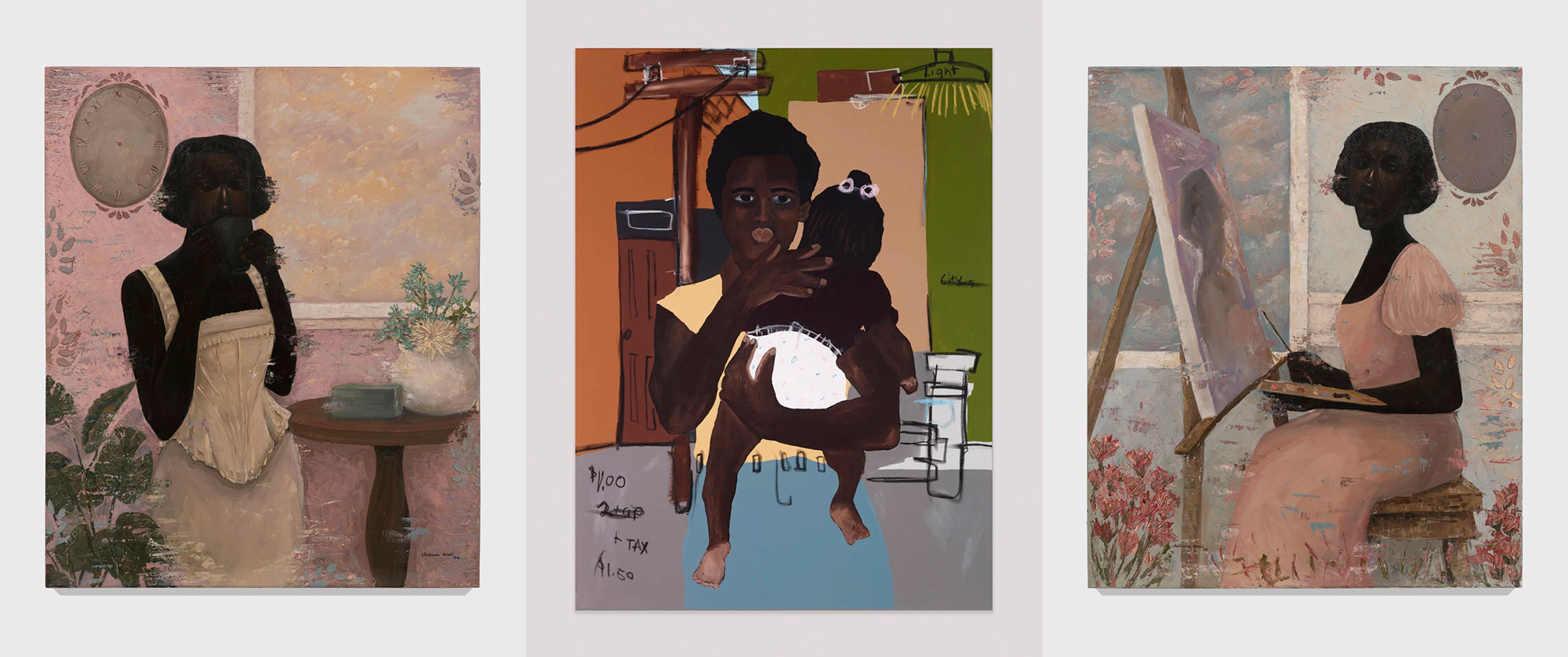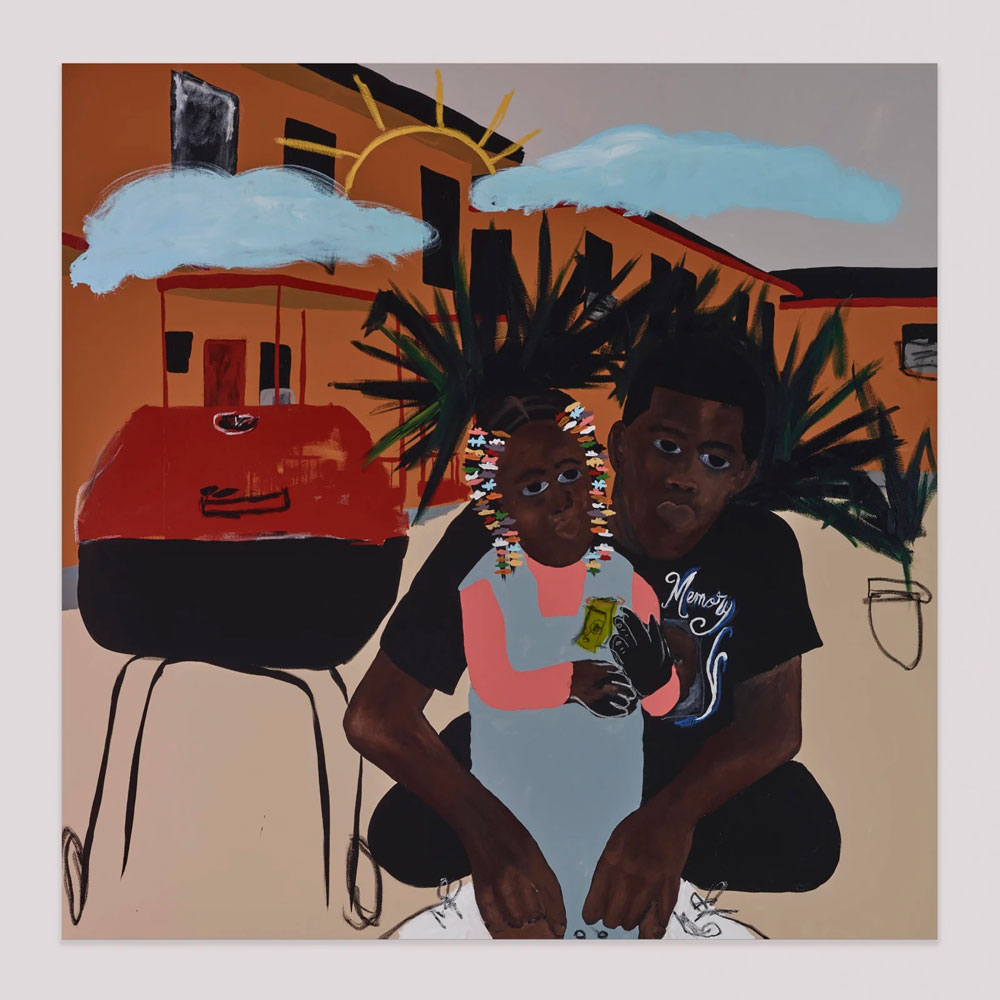ART CITIES:N.York-In Situ
 Featuring new and recent paintings by twelve artists, the group exhibition “In Situ”, is using Charlotte Perkins Gilman’s* seminal 1892 text “The Yellow Wallpaper” as a point of departure. The exhibition brings together paintings created throughout 2020 that offer reflections of life in isolation as necessitated by the current health crisis – private and still, yet restless and resolute.
Featuring new and recent paintings by twelve artists, the group exhibition “In Situ”, is using Charlotte Perkins Gilman’s* seminal 1892 text “The Yellow Wallpaper” as a point of departure. The exhibition brings together paintings created throughout 2020 that offer reflections of life in isolation as necessitated by the current health crisis – private and still, yet restless and resolute.
By Efi Michalarou
Photo: Marianne Boesky Gallery Archive
In “The Yellow Wallpaper” the unnamed narrator is confined to a room in her house as part of a rest cure, a nineteenth century medical treatment that strictly enforced a regimen of bed rest and social isolation. During her weeks in confinement, the narrator’s thoughts are slowly monopolized by the yellow wallpaper that surrounds her. Grounded by experiences of quarantine due to the pandemic, many of the artists utilized their surroundings to capture extended moments of stillness. Yet the range of paintings in In Situ are more than strict representations of the past year. While some of the work is figurative and depicts creature comforts of domestic spaces, or figures interacting or alone, others portray an occupant’s recurring perspective. The subjects and scenes of the works are not confined by the architecture of their interiors, but rather expand on imagination and the passage of time, offering meaningful depictions of isolation. In Gilman’s text, the narrator exclaims: “I never saw so much expression in an inanimate thing before, and we all know how much expression they have!” In Situ responds to this sentiment as the presented artists aptly pull inspiration from their own surroundings, embodying the tension between the safety of physical isolation and an urgency in the present moment to act and connect.
Cecily Brown makes paintings that give the appearance of being in continual flux, alive with the erotic energy of her expressive application and vivid color, shifting restlessly between abstract and figurative modes. Making reference to the giants of Western painting as well as to popular culture, she commands an aesthetic that breaks from the strictures of narrative to achieve an extraordinary visual and thematic fluidity. Jammie Holmes is a self-taught, neo-expressionist, painter with a raw and energy ladened portfolio of work that addresses religious, political, and contemporary issues. Through his seminal use of color and recurring symbolism, Holmes creates art works that provide viewers with a look into his complex thinking. Forrest Kirk studied at California State University, Los Angeles and spent time studying classical painting techniques in an atelier in Paris, France. The bold chromatic diversity of Kirk’s paintings are achieved using a variety of media ranging from oils and acrylic to bubble wrap, fabric and gorilla glue. His images often reference psychological uncertainty and anxiety arising from underlying power structures, specifically those experienced in contemporary urban settings. YoYo Lander is a figurative visual artist. Her art explores the essence of people of color. Her passion is to use body language as an introduction into the context. Choosing her subjects are very intuitive. She goes with what she feels. YoYo then takes several photographs of her subjects to capture an image that is definitive. Next, she combines several images to express the chosen image through individually dyed pieces of watercolor paper. Within the final piece one will find a sense of truth, perhaps a moment that you’ve seen or experienced. Maud Madsen’s work investigates remembrances and interrogates the idea of normalcy as a preferred narrative – the sanitized idea of memory versus the messier truths and discomforts of embarrassing admissions and taboo topics. The artist is also exploring the idea of communal memory, and how the general narrative of a group subsumes the specifics of an individual, if the collective narrative represents an ideal. Through the use of recurring characters and appropriated childhood spaces, her work explores her own memories and insecurities as they relate to her lived experience as a young woman. Chidinma Nnoli is a visual artist whose practice draws from personal, real-life experiences in challenging stereotypes, psychology and the cultural conditioning of women while exploring elements of identity, sexuality and mental health. Working predominantly in oil, Nnoli’s work confronts socially entrenched structures of patriarchal power and misogyny as enforced by the state, familial relationships and religious organisations. Fascinated with the notion of safe and enabling spaces, her work pushes back against reductive notions of femininity, gender roles and mental health in contemporary society. Collins Obijiaku is a young, up-and-coming artist from Kaduna, Nigeria. His work is a celebration of blackness through elegantly constructed portraits. Gazing at his paintings is to be transported into a world where black people exist for themselves, innately elegant and unfazed by the world and its never-ending problems. There is an affective connection between him and his subjects, which is made apparent by the graceful way he extends their complex personalities onto the canvas. Celeste Rapone fuses material invention, humour, high-low free play, tough art history and resourcefulness with the figure, all in service of detailed 21st-century narratives that prioritise women. Rapone is a 2013 MFA graduate of the School of the Art Institute of Chicago. As an abstract painter trained in Paris and New York, Lorna Robertson, uses movement to represent the life force to be found in all things. Real motion is expressed in dynamic poses of her figurative work, and in her still lives, contrasting colors create a sense of movement. Robertson’s charcoal figures demonstrate that she is also an accomplished draughtsman. The dynamic poses of figures striding, pointing or stretching are sketched in broad black strokes that emphasize muscular motion. Michaela Yearwood-Dan’s work explores ideas around class, race, gender, culture and nature. Her latest body of work was inspired by personal stories of love, loss and self-reflection all whilst remaining playful and light-hearted. Her vibrant and luxurious style is underpinned by an expansive repertory of cultural signifiers, borrowing freely from millennial culture, blackness and feminism: texting, acrylic-nails, gold-hoops, carnival culture, and a lush, omnipresent flora which evokes seeding, propagation, growth and alludes to the intimate, infinite possibilities of a diaspora. Participating artists: Cecily Brown, Olivia Erlanger, Jammie Holmes, Forrest Kirk, YoYo Lander, Maud Madsen, Chidinma Nnoli, Collins Obijiaku, Celeste Rapone, Lorna Robertson, Eleanor Swordy, and Michaela Yearwood-Dan.
*Charlotte Perkins Gilman (3/7/1860-17/1/1935) was American feminist, lecturer, writer, and publisher who was a leading theorist of the women’s movement in the United States.”The Yellow Wallpaper,” published in “The New England Magazine” in January 1892, is regarded as an important early work of American feminist literature for its starkly realistic first-person portrayal of the mental breakdown of a physically pampered but emotionally starved young wife.
Photo: Lorna Robertson, On a Scottish Shore, 2020, Oil on canvas, 190.5 x 299.7 cm, Courtesy of the artist and Ingleby Gallery, Edinburgh. © Lorna Robertson
Info: Marianne Boesky Gallery, 507 West 24 Street, New York, Duration: 7/1-7/2/2021, Tue-Sat 10:00-18:00 (Booking Required), https://marianneboeskygallery.com


Center: Michaela Yearwood-Dan, Tickle em pink (make em think)’, 2020, Oil, acrylic, charcoal, and ink on canvas, 200 x 150 cm, Courtesy of the artist and Tiwani Contemporary, London. © Michaela Yearwood-Dan
Right: Michaela Yearwood-Dan, The Belly of a Woman, 2020, Oil, pastel, ink and gold leaf on canvas, 200 x 150.2 cm, Courtesy of the artist and Tiwani Contemporary, London. © Michaela Yearwood-Dan


Center: Jammie Holmes, Property Tax, 2020, Acrylic and oil pastels on canvas, 121.9 x 91.4 cm, Courtesy of the artist and Library Street Collective, Detroit. © Jammie Holmes
Right: Chidinma Nnoli, None of these clocks work II, 2020, Oil and acrylic on canvas, 121.9 x 101.6 cm, Courtesy of the artist and Rele Gallery. © Chidinma Nnoli





Right: YoYo Lander, No Place to Make Love, 2020, Cut watercolor paper on watercolor paper, 76.8 x 51.4 cm, Framed Dimensions: 88.9 x 63.82 cm, Courtesy of the Artist. © YoYo Lander
